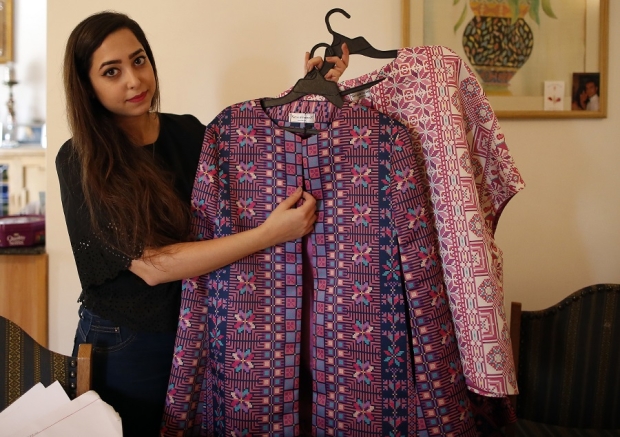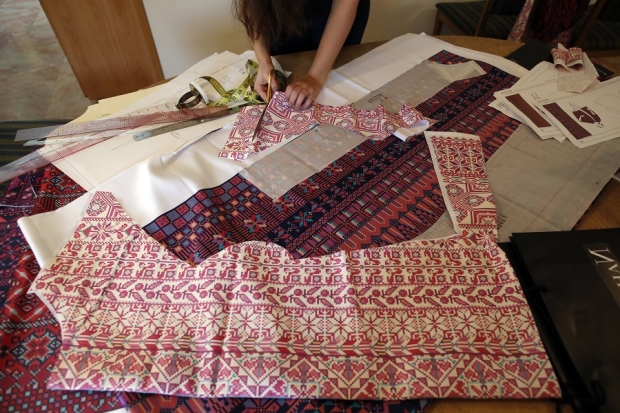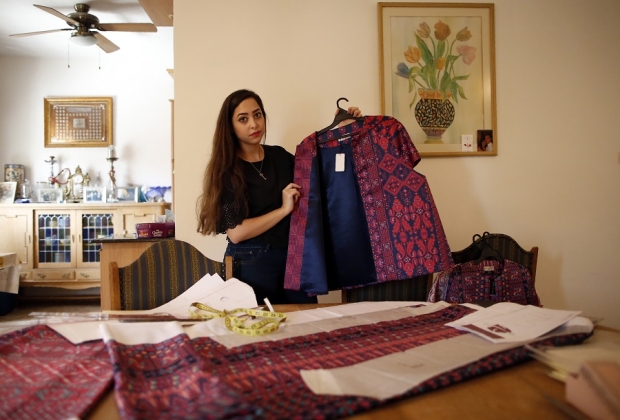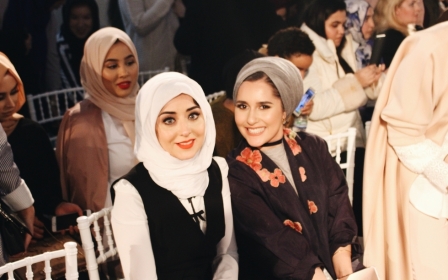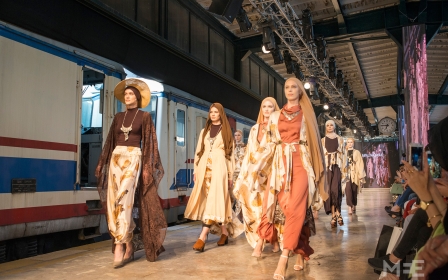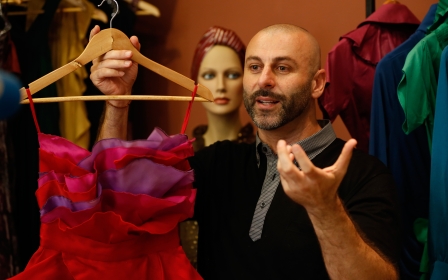Palestinian fashion designer breathes new life into tradition

by Shatha Yaish
Palestinian fashion designer Natalie Tahhan is hard at work in her Jerusalem studio, replacing the painstaking processes of cross-stitching and embroidery with a laptop computer and printed fabric.
Taking inspiration from traditional Palestinian patterns, Tahhan designs patterns digitally and then has them printed on satins and silks before piecing together her garments.
Her modern take on generations-old designs has attracted a keen following both locally and abroad, particularly in the Gulf, where she sells her clothes via the web.
"I wanted to do something new, modern, never seen on the market," the 27-year-old said, as she measured out fabric at her studio in her family home in Ras al-Amud, East Jerusalem.
Palestinians have for centuries painstakingly sewn long black dresses and adorned them with red embroidery, in designs still worn today in rural areas and at marriages and other celebrations.
The designs vary from region to region and tend to say something about the wearer.
"We can tell where the woman who wears it is from and if she is married or single," Tahhan said.
Several young Arab designers have sought to modernise traditional wear and bring the dresses of their ancestors - an increasingly rare sight today - to a new generation.
Tahhan, who studied in Doha and at the London College of Fashion, is among the few to do so in Jerusalem. She believes she is the only one to have abandoned traditional embroidery for her new method.
As the Palestinian territories lack the equipment she needs, she has her fabrics printed in Dubai.
They are then delivered to Jerusalem via Qatar and Jordan to circumvent the lack of direct shipments from the Gulf countries to Israel and the Palestinian territories.
'Proof of existence'
Maha Saca, director of the Palestine Heritage Centre in the occupied West Bank city of Bethlehem, says she supports efforts to breathe new life into traditional designs.
"Adding Palestinian motifs to modern wear is very important. It means we can wear a modern dress with Palestinian embroidery on it," she said.
The centre, established in 1991, boasts the largest collection of traditional Palestinian dresses.
"Embroidery is part of our identity and our proof of our existence in every Palestinian city and village," Saca said. "It shows the beauty and richness of our Palestinian heritage."
She is lobbying for traditional embroidery to be incorporated into Palestinian school uniforms.
Saca said top-end handmade dresses can cost between $1,500 and $2,000 because of the long hours of labour involved and the cost of materials.
She stresses the need to preserve hand embroidering techniques, but accepts that clothes are being produced in new and more modern ways.
"We support it 100 percent," she said.
Tahhan's first collection, consisting of five white and violet satin capes with shimmering geometric patterns, sold out completely in less than three months at a price of $550 a piece.
Most of the sales were to Gulf clients who bought the items online.
'Really worth it'
One of Tahhan's signature works is a cape inspired by designs from the West Bank city of Hebron, occupied by Israel for 50 years. The garment bears a succession of blue and pink squares over black fabric, and is open at the shoulders.
Tahhan's light fabrics work well in the Gulf market, where heavy black felt or thick cotton can become unbearable under the burning sun.
Her latest collection is called "Prints of Palestine."
Tahhan's location in Jerusalem, a city holy to Muslims, Christians and Jews, is also a plus for sales "despite the obstacles and difficulties" imposed by Israel's occupation, she said.
Israel seized the West Bank and East Jerusalem in 1967. It later annexed East Jerusalem in a move never recognised by the international community.
Palestinians see the eastern sector as the capital of their future state, while Israelis consider the entire city of Jerusalem their unified capital.
"I wanted to do something as a girl from Jerusalem," said Tahhan, her long black hair falling over her shoulders. "Why not create fashion here?"
"People love the idea of owning something made in Jerusalem, especially Palestinians abroad," she said.
"When they buy something they feel they are taking with them a small piece of the city."
New MEE newsletter: Jerusalem Dispatch
Sign up to get the latest insights and analysis on Israel-Palestine, alongside Turkey Unpacked and other MEE newsletters
Middle East Eye delivers independent and unrivalled coverage and analysis of the Middle East, North Africa and beyond. To learn more about republishing this content and the associated fees, please fill out this form. More about MEE can be found here.


